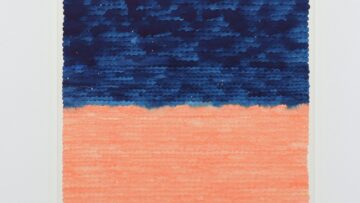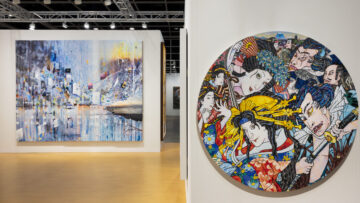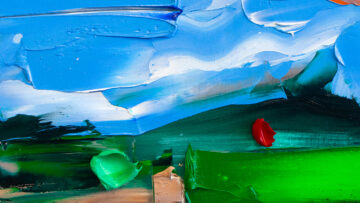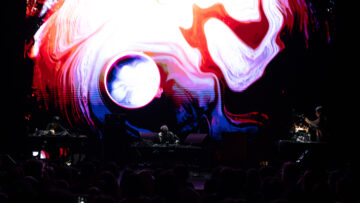Written by ART Driven Tokyo
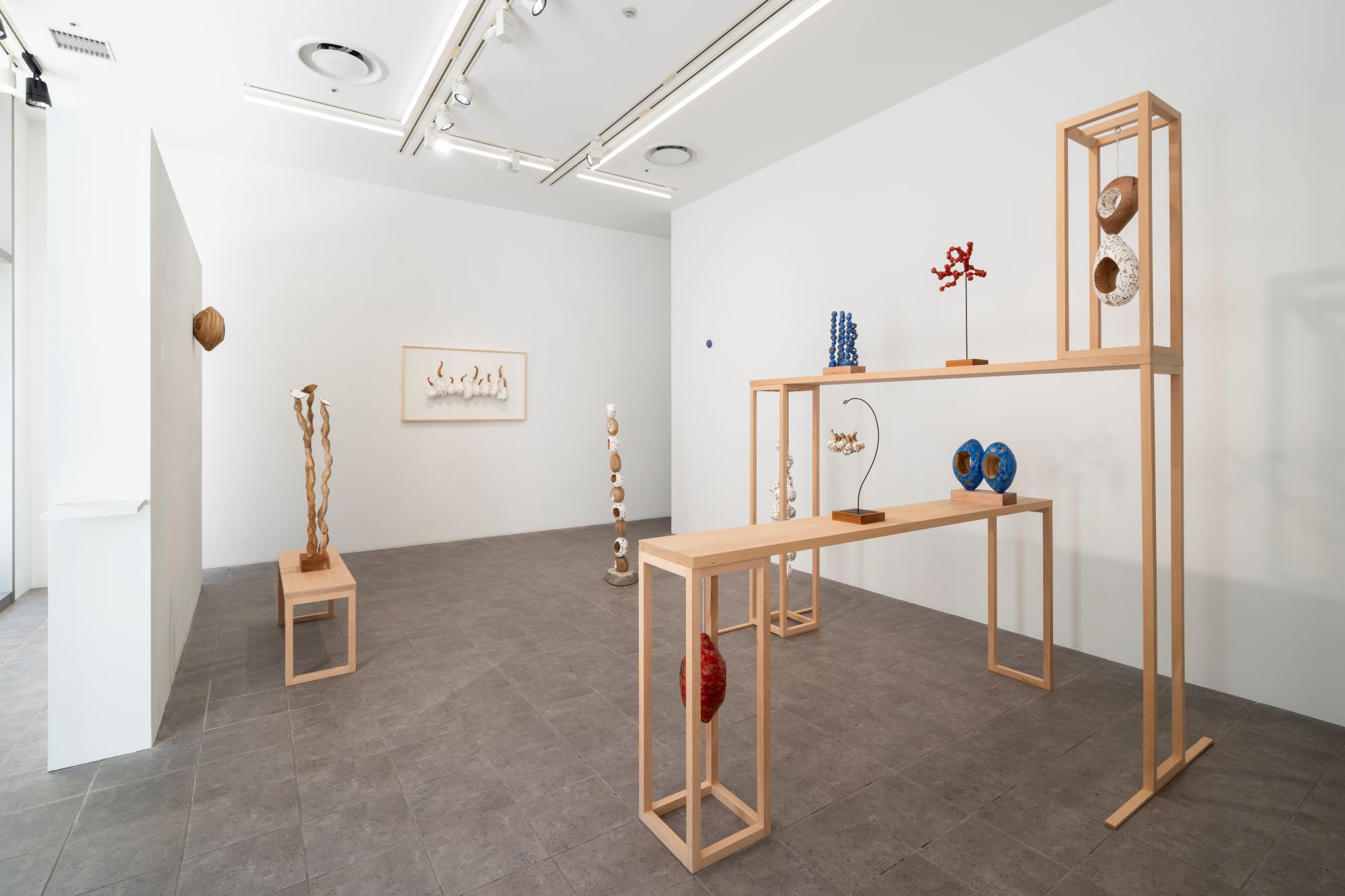
Courtesy of the artist and MARUEIDO JAPAN
Photo: KATO Ken
When I saw Daikoku Takayuki’s solo exhibition “GARDEN”, which the artist himself described as “it is possible to perceive the entire GARDEN as one single sculpture”, I understood why he used so many round sculptures with holes. Sculptor Daikoku Takayuki, by hollowing out the wood, also carves the space.
From the object’s perspective, the space is “outside,” but from the perspective of the space, the object is “inside.” From a different perspective, the inside becomes the outside, and the outside becomes the inside.
Depending on how you look at it, it could be said that the space is a work of art.
The solo exhibition “GARDEN” by Daikoku Takayuki, who has been active in Germany for about 6 and half years, is being held at MARUEIDO JAPAN in Akasaka, Tokyo, from November 17 to December 9, 2023. (The exhibition ended.)The artist also says, “The GARDEN suggests the concept of a strolling garden.” Then, moreover, I understood why the audience would be attracted to and energized by these round things that look like flowers, buds, nuts, seeds, eggs, and cells.
Ball Make Pruning and Scattering. Landscape Similar to a Japanese Traditional Garden
We can see similar techniques to Japanese traditional gardening: Ball making(Tamazukuri in Japanese), ball-scattering(Tamachirashi), ball pruning and arranging(Danzukuri), and seashell arranging (Kaizukuri).
In ball making, the leaves and branches of the main branch are arranged in a cluster at the tip of the branch, and the balls are placed near the trunk. If balls are arranged as if they are scattered around the trunk, they are called Tamachirashi. Danzukuri is a technique in which the balls are uniformly shaped and regularly arranged throughout the tree. Kaizukuri is a method of arraning flattend balls like seashells.
The organic sculptures carved from camphor wood and painted with stucco are inspired by the artist’s childhood memories of rice ears in the countryside, the shapes of trees and plants in the mountains and along rivers, and the landscape of Lake Biwa which the artist saw as a young child.
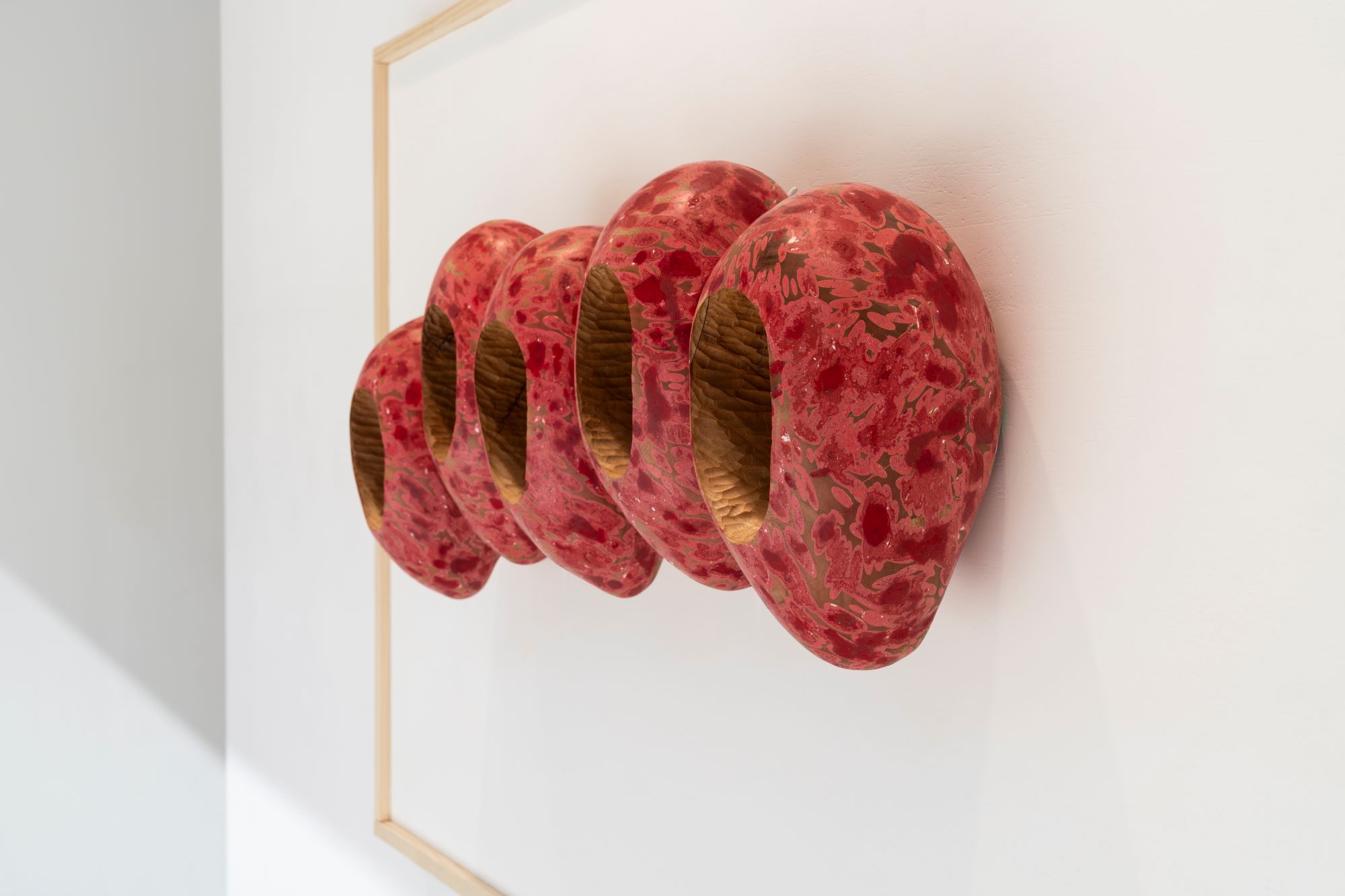
Courtesy of the artist and MARUEIDO JAPAN
Photo: KATO Ken
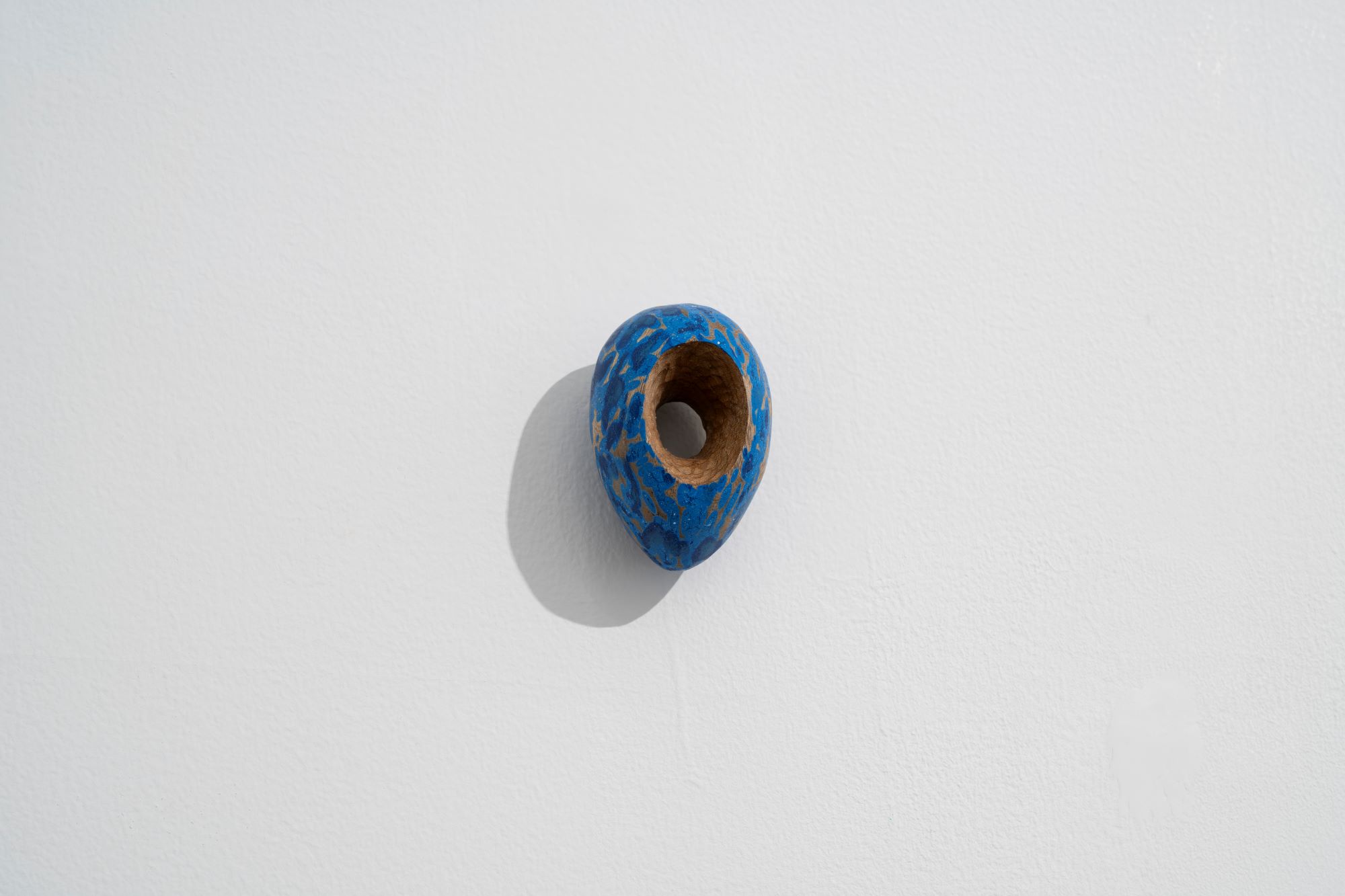
Courtesy of the artist and MARUEIDO JAPAN
Photo: KATO Ken
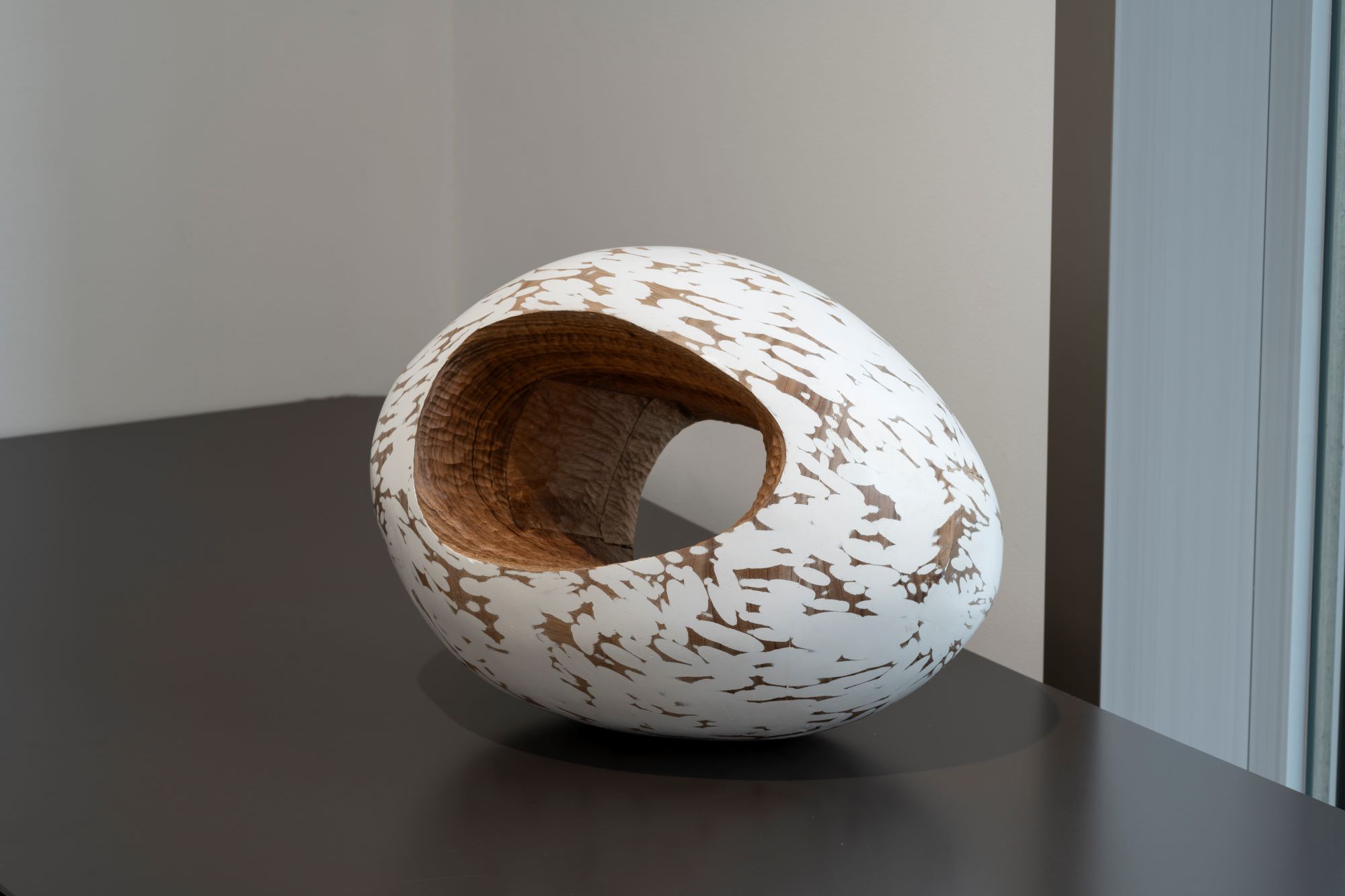
Courtesy of the artist and MARUEIDO JAPAN
Photo: KATO Ken
Recognized by Renowned Japanese Antique dealers. Harmonious beauty that engraves memories
Although I have never seen Lake Biwa, facing the work, I felt a pleasant illusion of wind blowing across the lake and even smell its fragrance. In Daikoku’s past writings and interviews, he has sometimes mentioned his separation from his family. I wonder if Daikoku’s emotions were greatly moved when he created this group of works, which seem to have been left behind on the shores of Lake Biwa. Did he ever remember or heal his memories by carving them?
Daikoku wrote about the concept of the exhibition as follows: The UK’s Mên-an-Tol, which are also known as ”the stones with holes”, consist of two granite pillars and one holed stone that have been placed in a field in Cornwall. Sculptor Sir Antony Mark David Gormley writes in his book Shaping the World: Sculpture from Prehistory to Now that the pillars of this ruin are seen as symbols of men and the holed stone is a symbol for women, and the site can be interpreted as a potential place for rebirth. Pillars have been understood as a fundamental form for life in various cultures since ancient times. This is illustrated by the many examples of pillars that exist, such as the totem poles of the US, the lingas of Cambodia, Japanese pillars, and Constantin Brâncuși’s Endless Column.
Totem poles were also made to commemorate special events for individuals and families, and they contained people’s wishes.
In the West, there is a garden technique called topiary, in which trees are trimmed to form rounded shapes. They are often used to create three-dimensional geometric patterns in the shape of birds and animals. This is often seen in English gardens. Objects made by crawling flowers, ivy, or other vines on a wire frame may also be included. The work in the photo below (right), in which nuts-like objects are hung from iron with nylon string, also has a topiary-like element.
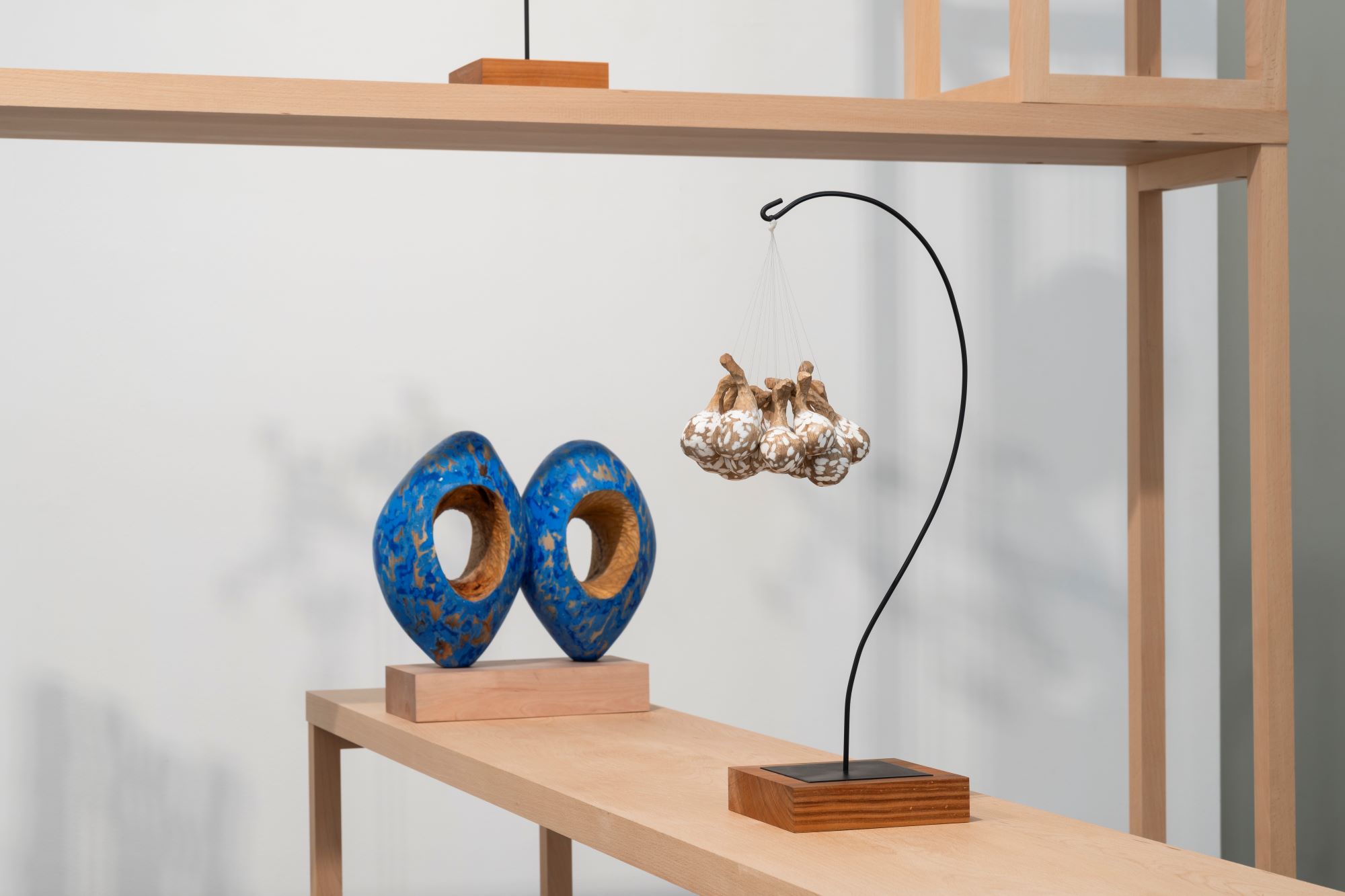
Courtesy of the artist and MARUEIDO JAPAN
Photo: KATO Ken
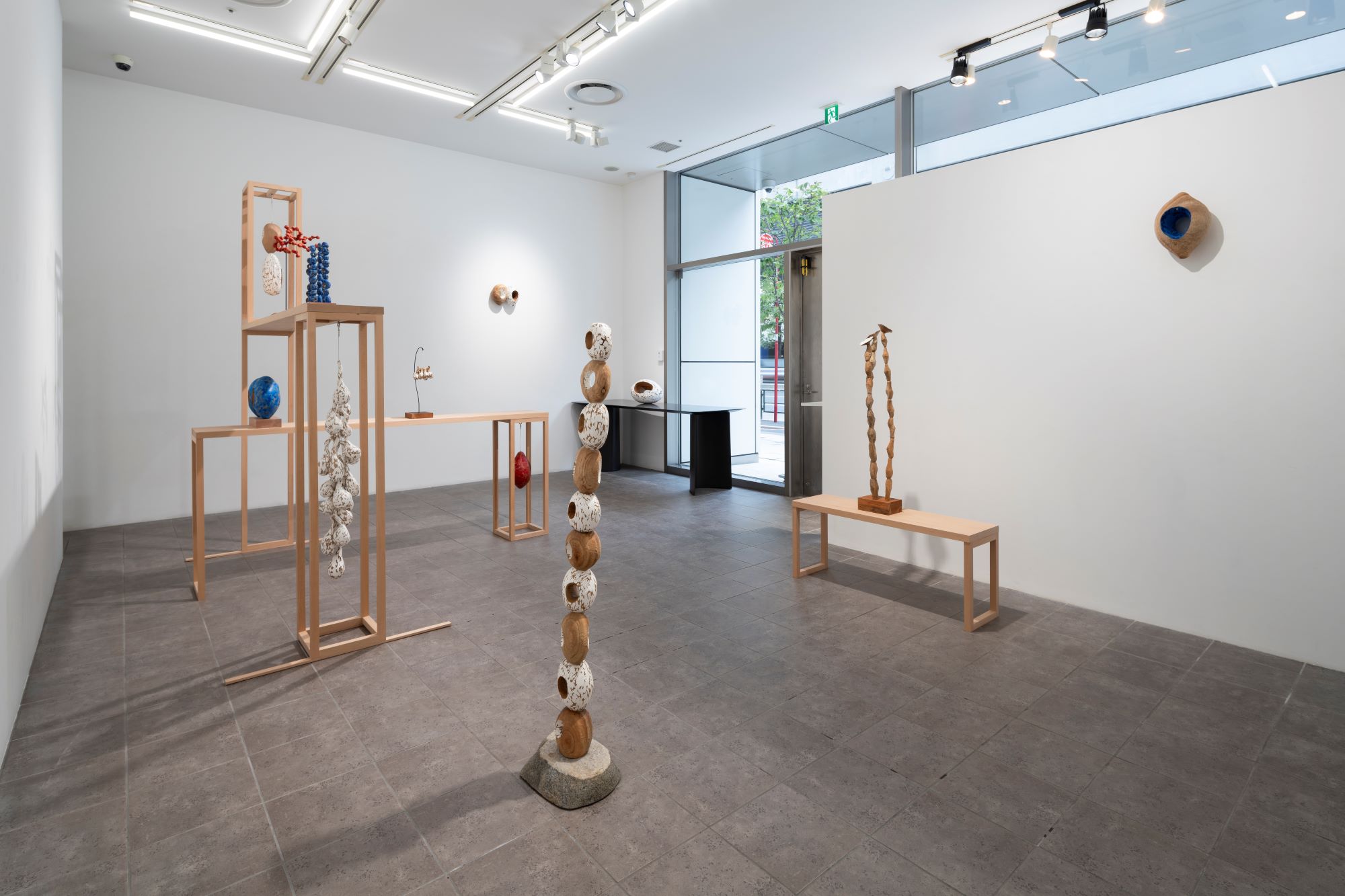
Courtesy of the artist and MARUEIDO JAPAN
Photo: KATO Ken
Spots and Lines, Creating a Showcase. Visualizing the Cycle of Life
Daikoku’s works, which attempt to visualize the flexible cycle of life created by the diversity of nature, are in the collections of some of Japan’s well-known antique dealers. It is not difficult to imagine why.
For example, “Spots and Lines” is an important component of traditional eastern ink painting. Each of the round objects in the photo below is a “spot,” and when the spots are connected, they form a “line”.
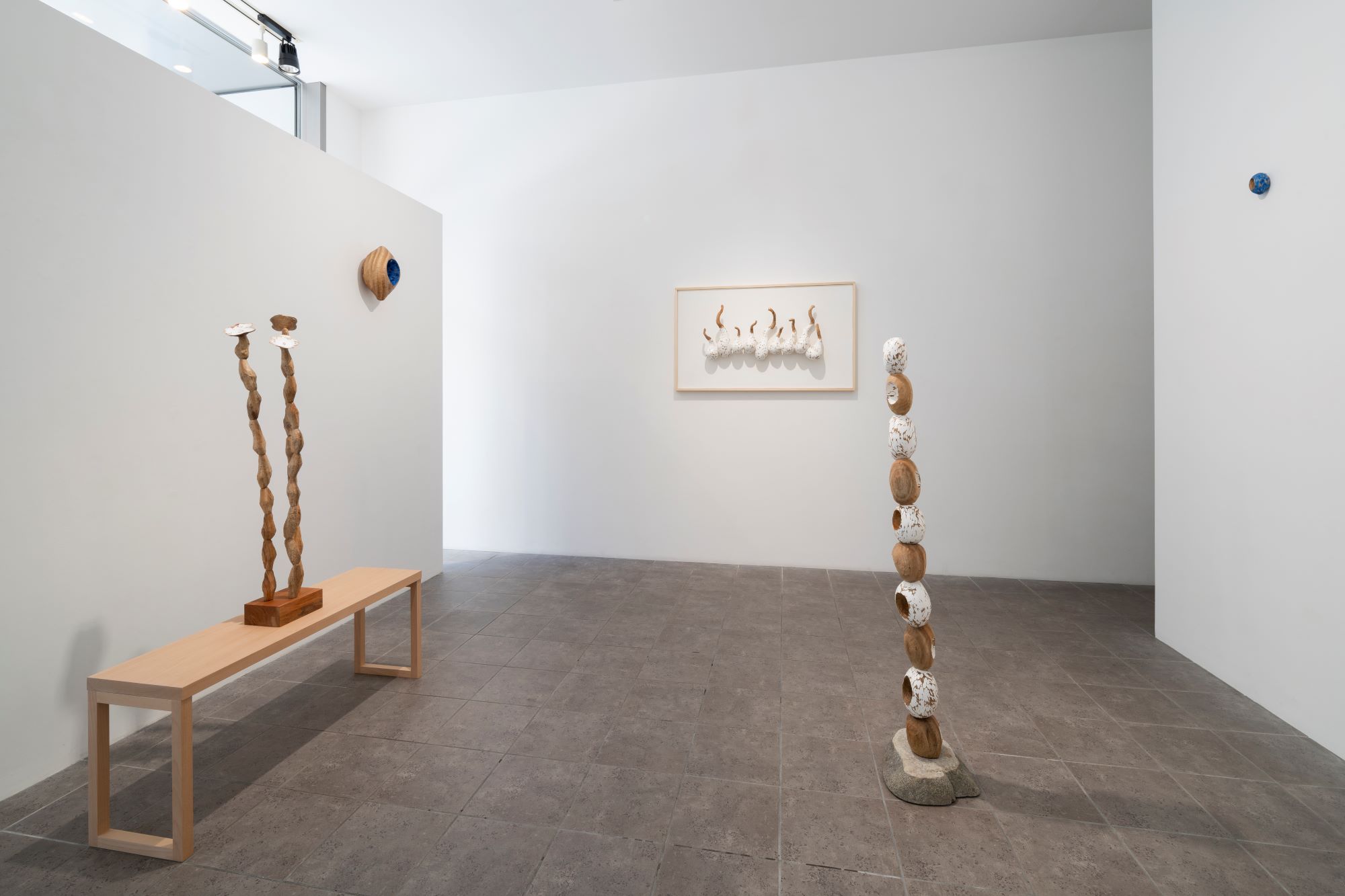
Courtesy of the artist and MARUEIDO JAPAN
Photo: KATO Ken
The exhibition’s concept of “ones that are both whole and parts” and “rising and falling” is similar to the way traditional Japanese arts, such as flower arrangement(Kado), create “highlight scene”. As can be seen in the photo below, the positioning of the works in the exhibition is very interesting. The circular spots that form a line move up and down with great momentum. It’s fun to look at. Visitors can interact with the works as if they were walking around a strolling garden, crossing their eyes from top to bottom, left to right, and side to side.
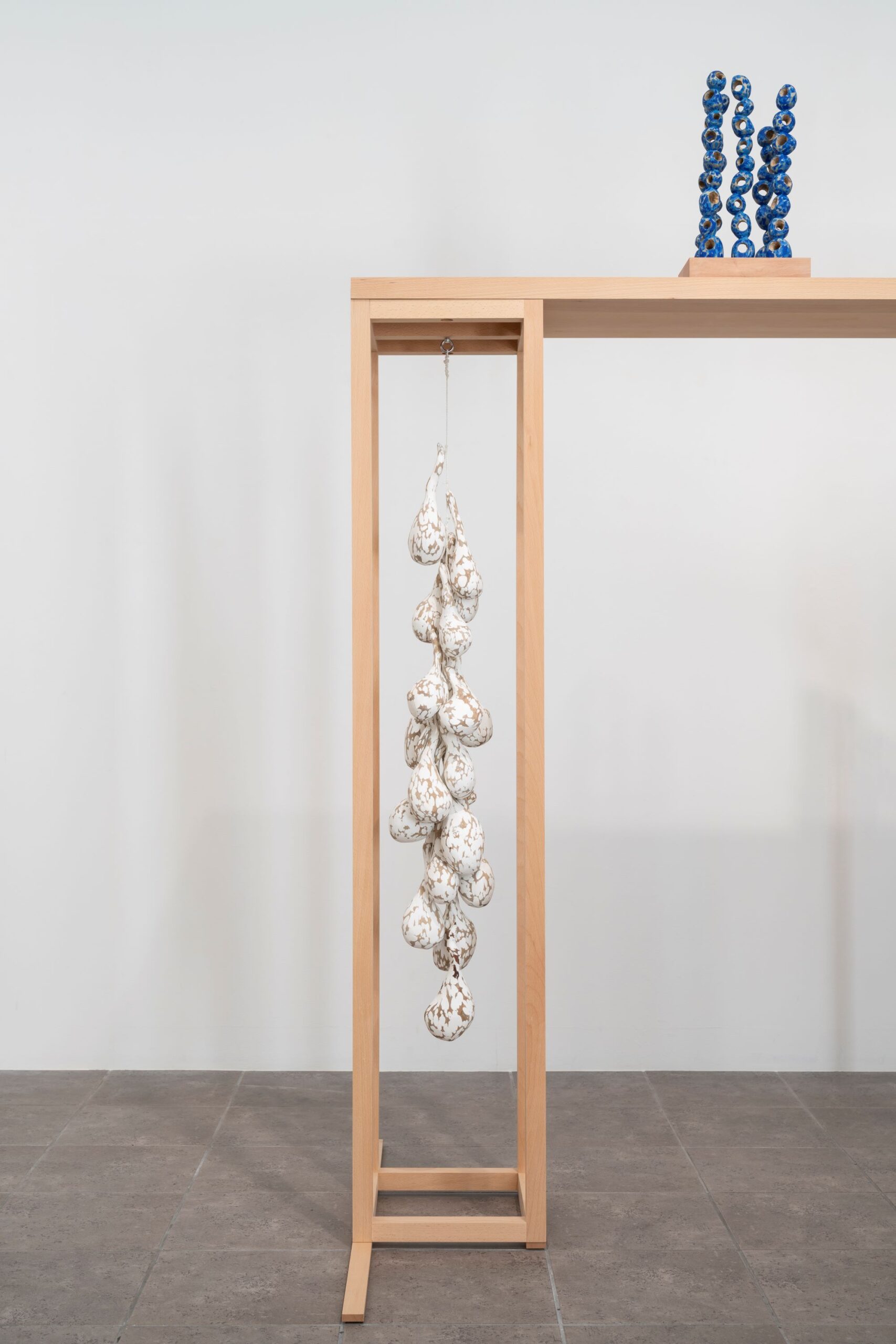
Courtesy of the artist and MARUEIDO JAPAN
Photo: KATO Ken
“Conscious of a fluctuation-like something that occurs between two conflicting meanings”
Daikoku is an artist who has been conscious of “something that occurs between conflicting meanings at first sight”. He uses the term “Inter-Vibration” as a concept that runs through the entirety of his creative world. It is as follows.
“I am conscious of a fluctuation-like something that occurs between two conflicting meanings; for example, the fluctuation between nature and human societies, two-dimensional space and three-dimensional space, stillness and motion, or lines and the ground. Something is always occurring between two items that are seemingly different- such as those seen in nature, culture, and human psychology. I feel that this fluctuation may be called a relationship or an event. I feel that this world is made up of the continuity of those relationships.”
Daikoku talks about the beauty of “something that occurs between conflicting meanings” on YouTube.
I felt that Daikoku’s philosophy, which regards the fluctuations that occur between two different items as “events” and feels life in them, has something in common with the British empiricism represented by Hume. Hume and others emphasized inductive proofs based on experience of events, denying absolutes and the absoluteness of science. They believed that there are no objective, absolute facts, and that causal relationships are merely tentative, inductive proofs based on current, observable experiences, which are created by human beings.
Human beings can only say, “It has been so,” or “It will be so.” Man is incapable of knowing cause-and-effect relationships; one plus one is two, and that may change. Hume denied the existence of an absolute “I,” saying that life is nothing but a bundle of perceptual experiences such as heat and pain.
And that bundle of perceptions is fleeting and beautiful. That is life.
While viewing this exhibition with an awareness of the “fluctuations” that occur in between, I recalled small events and casual conversations with loved ones one after another, reaffirming the transience and uncertainty of existence, but also gaining a sense that “I am indeed alive,” and I also gained a sense of vitality, as if I were slowly regenerating myself.
The viewer will be reminded of a meadow or lakeside somewhere in the world and will be able to reflect for a while on their life journey, and on life itself.
DAIKOKU Takayuki
1976 Born in Shiga, Japan
1999 Graduated from BA Fine Art Department, Osaka University of Arts
2001 Graduated from MA Fine Art Department, Osaka University of Arts
2001-03 Stayed in Berlin, Germany
2011-16 Stayed in Rathenow, Brandenburg, Germany
2016- Based in Shiga, Japan
Artist Website: https://k-daikoku.net/
Exhibition Overview
Title: GARDEN
Period: 2023.11.17 – 12.09
Artist: DAIKOKU Takayuki
Exhibition Website: http://marueidojapan.com/info/exhibition/garden/
Venue: MARUEIDO JAPAN
ARK HILLS FRONT TOWER 1F, 2-23-1
AKASAKA, MINATO-KU, TOKYO, JAPAN
ZIP 107 0052
Tel: 03-5797-7040
Opening Hours:11 a.m. – 6 p.m.
Closed: Sunday, Monday, and National Holidays
Access:
■TOKYO METRO NAMBOKU LINE and GINZA LINE “Tameikesanno station” Exit 12 : 4 mins. walk
■TOKYO METRO NAMBOKU LINE “Roppongi 1-chome station” Exit 3 : 5 mins. walk
■METROPOLITAN BUS route 01 For Shimbashi “Akasaka Ark Hills” : 0 min. walk
MARUEIDO JAPAN
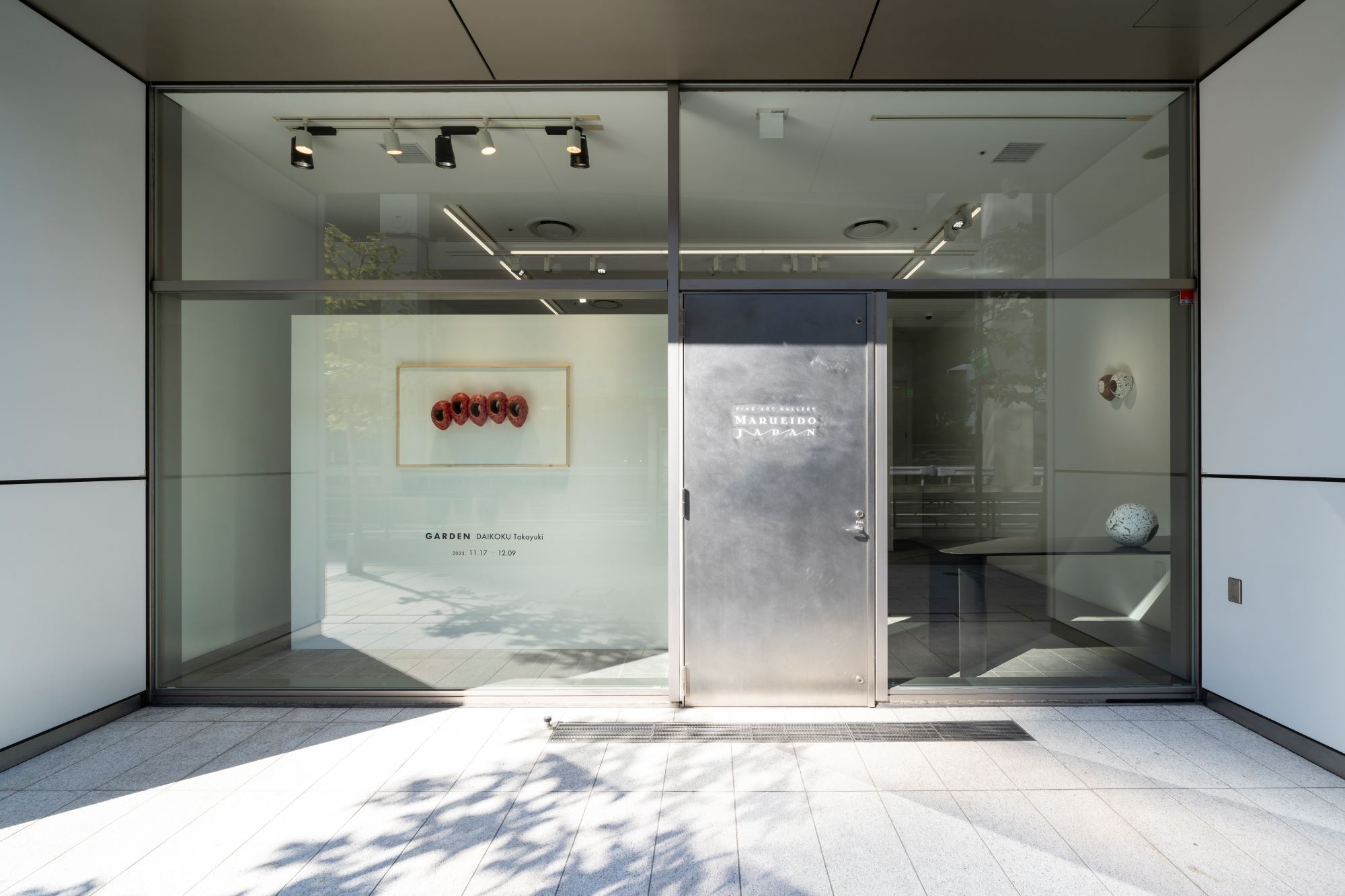
Photo: KATO Ken
MARUEIDO JAPAN is an art gallery featuring modern and contemporary art that opened in Akasaka, Tokyo in April 2018. It is located on the 1st floor of Akasaka Ark Hills Front Tower along Roppongi Dori between Roppongi and Tameike.
MARUEIDO, a group company, has been in business for 100 years and has long supported the Japanese modern art market. 11 artists, including Okumura Togyu, Kawabata Ryushi, Domoto Insho, Higashiyama Kaii, and Maeda Seison, participated in the 1960 exhibition “New Japanese Painting”.
As a more contemporary gallery, MARUEIDO JAPAN holds several special exhibitions a year and actively participates in art fairs in Japan and abroad, focusing on introducing Japanese artists.
Artists represented include Ozu Wataru, Kageyama Moeko, Kadota Mitsumasa, Kitabayashi Kanako, Daikoku Takayuki, Hanzawa Tomomi, Daijiro Hama, Fujisaki Ryoichi, Masuda Masahiro, Yamaguchi Soichi, Yokomizo Miyuki, and Aiko Robinson.
Website: http://marueidojapan.com/

